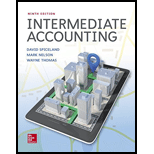
Stock options; graded vesting; IFRS
• LO19–2, LO19–14
IFRS
Refer to the situation described in P 19–2. Assume Pastner prepares its financial statements using International Financial Reporting Standards (IFRS).
Required:
How might your responses to requirement 1 and requirement 2 differ using IFRS? Explain.
P 19–2
Stock options; graded vesting
• LO19–2
January 1, 2018, the company issued 400,000 executive stock options permitting executives to buy 400,000 shares of Pastner stock for $34 per share. One-fourth of the options vest in each of the next four years beginning at December 31, 2018 (graded vesting). Pastner elects to separate the total award into four groups (or tranches) according to the year in which they vest and measures the compensation cost for each vesting date as a separate award. The fair value of each tranche is estimated at January 1, 2018, as follows:
| Vesting Date | Amount Vesting Fair | Value per Option |
| Dec. 31, 2018 | 25% | $3.50 |
| Dec. 31, 2019 | 25% | $4.00 |
| Dec. 31, 2020 | 25% | $4.50 |
| Dec. 31, 2021 | 25% | $5.00 |
Required:
1. Determine the compensation expense related to the options to be recorded each year 2018–2021, assuming Pastner allocates the compensation cost for each of the four groups (tranches) separately.
2. Determine the compensation expense related to the options to be recorded each year 2018–2021, assuming Pastner uses the straight-line method to allocate the total compensation cost.
Want to see the full answer?
Check out a sample textbook solution
Chapter 19 Solutions
Loose Leaf Intermediate Accounting
- I am searching for the accurate solution to this general accounting problem with the right approach.arrow_forwardNeed Help About this Financial Accounting Question With Correct Answer..arrow_forwardPlease provide the correct answer to this general accounting problem using valid calculations.arrow_forward
- I need help solving this general accounting question with the proper methodology.arrow_forwardNo AI The accounting principle that requires matching revenues with related expenses is the:A. Going Concern PrincipleB. Matching PrincipleC. Cost PrincipleD. Full Disclosure Principlearrow_forwardRevenue is recognized in the accounting records when it is:A. CollectedB. EarnedC. DepositedD. Reportedarrow_forward
- The accounting principle that requires matching revenues with related expenses is the:A. Going Concern PrincipleB. Matching PrincipleC. Cost PrincipleD. Full Disclosure Principlearrow_forwardWhich account is a contra-asset?A. Accounts PayableB. Accumulated DepreciationC. Notes ReceivableD. Prepaid Rentneedarrow_forwardIf cash is received before services are provided, what is the journal entry?A. Debit Revenue, Credit CashB. Debit Unearned Revenue, Credit CashC. Debit Cash, Credit Unearned RevenueD. Debit Accounts Receivable, Credit RevenueCorrectarrow_forward
- If cash is received before services are provided, what is the journal entry?A. Debit Revenue, Credit CashB. Debit Unearned Revenue, Credit CashC. Debit Cash, Credit Unearned RevenueD. Debit Accounts Receivable, Credit Revenuecorrectarrow_forwardGAP Corp. is a calendar year S corporation with three shareholders. George and Anna each own 49 percent of the stock. Peter owns 2 percent of the stock. The corporation was formed on January 2, Year 1, and has been an S corporation since its inception. Using the exhibits, prepare a schedule of GAP's income, gain, loss, and deduction items for Year 2. In column B, enter the amount for federal income tax purposes. In column C, enter the amount included in GAP's Form 1120S ordinary business income (OBI) or loss. In column D, enter the amount included on GAP's Schedule K as a taxable or deductible separately stated item. Each item may have amounts entered in ordinary business income, separately stated items, or both. Enter income and gain amounts as positive numbers. Enter losses and deductions as negative numbers. If the amount is zero, enter a zero (0). A B C D 1 Income, Gain, Loss, and Deduction Items Amount for Federal Income Tax Purposes Ordinary Business Income…arrow_forwardIf cash is received before services are provided, what is the journal entry?A. Debit Revenue, Credit CashB. Debit Unearned Revenue, Credit CashC. Debit Cash, Credit Unearned RevenueD. Debit Accounts Receivable, Credit Revenue need helparrow_forward
 Cornerstones of Financial AccountingAccountingISBN:9781337690881Author:Jay Rich, Jeff JonesPublisher:Cengage Learning
Cornerstones of Financial AccountingAccountingISBN:9781337690881Author:Jay Rich, Jeff JonesPublisher:Cengage Learning

